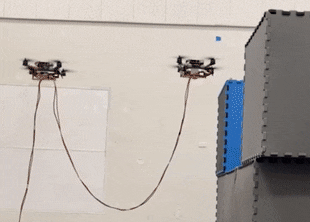American engineers have calculated the maximum flight altitude of a quadcopter powered by a cable of different thickness, above which the mass of the cable and the current loss in it do not allow the drone to maintain its flight. They also tested a bundle of two drones powered by a wire, expanding the possibilities compared to using a single device. The article will be presented at the IROS 2022 conference, its preprint is available at arXiv.org .
Almost all multicopters are not tied to the launch site and receive energy from batteries, but there are exceptions in which the engines are powered by wire. This prevents the drone from flying far away, but in some tasks it is not required. A good example of such a system is the drone of the Latvian company Aerones, designed for washing the blades of wind turbines. It rises into the air to the level of the blades and processes them with a cleaning solution, receiving it through a tube and power through a wire. A stationary power supply circuit is also used for other applications, such as painting and apple picking .
Despite the fact that drone power by wire has been used in practice for several years, there are still few works that analyze the possibility and limitations of this approach. Engineers from the University of California at Berkeley, led by Koushil Sreenath, filled this gap by calculating the basic parameters of such a system and checking the conclusions in practice.
The system described by them consists of a quadrocopter connected to a ground power source via a wire. It is assumed that in order to reduce transmission losses between the current source and the drone, a high voltage is maintained, which is then lowered to operating values on the quadcopter itself. As the height increases, the weight of the hanging part of the wire also increases, so the drone needs more energy to stay in the air. However, even with high voltage and efficient conversion, an increase in the power of the power supply leads to an increase in transmission losses, and at a certain height it is no longer able to compensate for the increase in losses.
The authors checked the calculations on a quadrocopter connected to a 1200 watt power source with a 7.62 meter long wire. The power supply produces a current of up to 20 amperes and a voltage of 60 volts, which is lowered to 12.6 volts on the drone, which is necessary to power the engines. During the experiments, the authors changed the cable thickness (10, 12 and 14 AWG ), flight altitude and voltage. Experiments and calculations of power consumption have shown that the discrepancies between the model and the real quadcopter do not exceed five percent. They also gave an example of calculating the critical altitude. If the drone is powered by a 12 AWG thick cable and hangs directly above the power source, then with a cable length above 9.43 meters, the drone can no longer climb to the maximum height and fully straighten it.
Finally, engineers have created a system of two quadrocopters, one of which is connected to a power source, and the second to the first drone. This allowed him to fly through the opening without catching the wire on the obstacle.
A group of engineers from this laboratory also specializes in folding drones. We talked about how they taught the drone to fold its shoulders in flight to overcome narrow obstacles and grab cargo.
Grigory Kopiev

